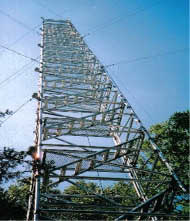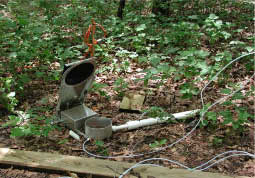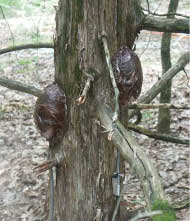Regulation of carbon exchange and water use in an Ozark forest: Proposing a new strategically located AmeriFlux site in Missouri
(Joint with University of Missouri and ATDD/NOAA)
Objective
The overarching objective of this project begun in late 2003, is to measure and explore controlling mechanisms of exchanges of CO2, water vapor and energy fluxes between a forest ecosystem and the overlying atmosphere at a strategic location along important ecological and climatologic gradients and use its strategic location to facilitate cross-site synthesis activities and provide support to the broad carbon cycling research community for studying issues at regional scales. The site is located in the Ozark region of central Missouri occupied by upland oak-hickory forests. The project began in September of 2003. With nine months of intense tower and flux system installation and supporting facility construction, the site became fully operational and started to generate data streams, including fluxes, met data, sap flow, soil respiration, and high precision CO2, in early June of 2004.
Goals
To obtain long-term, quality-assured datasets of CO2, water vapor and sensible heat exchanges using the eddy covariance method and to interpret these measurements based on complementary physiological, biophysical, biochemical, and biogeochemical process studies, system modeling approaches, and comparative studies with other AmeriFlux sites(http://public.ornl.gov/ameriflux/). These observational and modeling studies will provide empirical data and establish theoretical bases for predicting ecosystem carbon balance and water use under changing environmental conditions. This project will lead to improved climate datasets and models needed for policy making with respect to safe levels of greenhouse gases for the Earth system.
Approach
The project deploys two eddy covariance systems, one above canopy and one below canopy, to monitor exchanges of CO2, water vapor, and sensible heat fluxes in conjunction with measurements of radiation, temperature, humidity, wind speed and other meteorological variables. Two vertical profiling systems are used to determine canopy air space storages of CO2, water vapor and sensible heat. The high precision CO2 concentration measurements with air sample drying are conducted at the top of the tower and are integrated as part of the CO2 profiling system. Eight soil chambers are used to measure soil respiration at different locations around the tower. Sap flow measurements are conducted for 24 dominant, overstory trees representing a range of stem diameters and species. Hydraulic conductivity and water relations of current-season shoots of important species are monitored. Existing stocks of carbon for soils and vegetation are determined. About 250 trees are monitored for stem circumference growth. Litter production is measured with collection baskets. An under-canopy tram is being setup for measuring radiative transfer through the canopy. Foliar biochemical experiments are conducted using hydraulic lifting platforms during the growing season. These different varieties of measurements are being synthesized with the terrestrial fluxes and pools integrated simulator (FAPIS) that is developed in collaboration with the AmeriFlux data assimilation project. Cross-site syntheses are conducted through timely data sharing through the AmeriFlux data management system and through direct interactions with PIs at other sites.
Results to Date
The 2004 flux and meteorological data have been documented and submitted to the AmeriFlux data management for sharing with the general community. Flux data and other complementary datasets are now being analyzed. So far analyses have yielded several important findings:
- Net ecosystem exchanges (NEE) of carbon dioxide in this Ozark forest are surprisingly high, considering the transitional location of this site along climate and vegetation gradients. Peak NEE of carbon dioxide frequently reached ~ 30 µmol m-2s-1, in contrast to ~ 20 µmol m-2s-1 at the Harvard Forest site in the same year. Detailed leaf physiological measurements revealed values of Vcmax at the top of canopy around 100 µmol m-2s-1. The obtained leaf biochemical parameters were used to conduct model simulations which yielded flux magnitudes similar to those of observed fluxes. The surprisingly high NEE at this site is likely a result of enhanced supply of nutrients accumulated during previous dry years and available in this relatively wet year. Studies are now being conducted to examine this hypothesis. If confirmed, this finding could have significant implication for studying flux temporal and spatial variations.
- Biomass enthalpy change and metabolic energy storage are significant components of the land surface energy budget. The energy balance closure issue (the sum of latent, sensible and ground heat fluxes is always less than the net radiation, about 70 - 80%) exists at almost every eddy covariance flux site. The imbalance is most serious during nighttime and at sites with high stature vegetation. It has been puzzling flux researchers for a long time. This energy imbalance has led many investigators to question the validity of the technique in measuring CO2 fluxes. To examine this issue, we used the FAPIS model to simulate energy dissipation in our Missouri Ozark forest ecosystem. We found that biomass enthalpy change and to a lesser degree metabolic energy storage are important for closing the surface energy budget. These two components have been neglected in previous studies. The biomass enthalpy change rate has diurnal variations. Its value can reach as high as 100 Wm-2 in the day or as low as -100 Wm-2 in the night. The peak value for the metabolic energy storage (free energy change during the photosynthetic or respiratory process) can reach more than 10 Wm-2 during day and has a value ~ - 1 Wm-2 during nighttime. The sum of biomass enthalpy change and metabolic energy storage represents about 20% of the net radiation during day but the percentage is much higher during nighttime. This finding not only solves the energy imbalance puzzle at eddy covariance sites but also points to a critical deficiency in current climate predicting models. These models do not consider biomass energy storage and yet as revealed in this study, biomass energy storage can be much larger than radiative forcings of atmospheric greenhouse gasses and aerosols.
- Different species may have evolved different water use strategies in the Ozark forest community. Sapflow measurements indicate that species may use water in disproportion to their status in the community. For example, oaks represent 63% of the total basal area and 35% of the total sapwood area but represent 51% of the total transpiration stream. These results indicate that studies of water use by forests need to consider within-canopy variations in environmental conditions and changes in root structures because different species may occupy different levels inside the canopy and in the soil which can thus experience drastically different radiation, temperature and moisture regimes.
- In collaboration with the AmeriFlux data assimilation project, a comprehensive optimization method has been developed for A/Ci curve analysis. This new method completely removes the need of a priori selection of critical internal CO2 partial pressure (Ci) values for estimating leaf biochemical parameters from A/Ci measurements in conventional A/Ci curve analysis methods, which can cause serious errors in estimated biochemical parameters and cause biases in ecosystem models that use these parameters. A software package (OptimalACi) has been developed for sharing with the community.
Deliverables
Gu, L., S. G. Pallardy, P. Hanson and S. D. Wullschleger, 2005. A comprehensive optimization method for objective estimation of parameters in biochemical models of leaf photosynthesis, Plant Cell and Environment (in review).
Gu, L., T. Meyers, P. Hanson, S. G. Pallardy, S. D. Wullschleger, and B. Yang, 2005. Biomass enthalpy change and metabolic energy storage as important components of land surface energy budget (in prep).
Gu, L., E.M. Falge, T. Boden, D. D. Baldocchi, T. A. Black, S. R. Saleska, T. Suni, S. B. Verma, T. Vesala, S. C. Wofsy, and L. Xu, 2005. Objective threshold determination for nighttime eddy flux filtering, Agricultural and Forest Meteorology, 128, 179-197.
Baldocchi, D.D., T.A. Black, P. Curtis, E. Falge, J.D. Fuentes, A. Granier, L. Gu, A. Knohl, K. Pilegaard, H.P. Schmid, R. Valentini, K. Wilson, S. Wofsy, L. Xu and S. Yamamoto, 2005. Predicting the Onset of Photosynthesis of Deciduous Forests with Soil Temperature and Climate Data: A Synthesis of FLUXNET Data. International Journal of Biometeorology, DOI: 10.1007/s00484-005-0256-4.
Yang, B., P. J. Hanson, J. S. Riggs, S. G. Pallardy, L. Gu, M. Heuer, K. P. Hosman, T. P. Meyers, and S. D. Wullschleger, 2005. Importance of CO2 storage and its bias pertinent to vertical configuration of a profile system (in prep).
For more information, contact:
Lianhong Gu (lianhong-gu@ornl.gov, 865-241-5925)
Revised: 8/04/05
|





